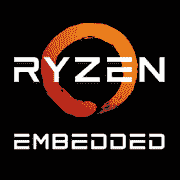AMD Ryzen Embedded R1102G

AMD Ryzen Embedded R1102G: Compact Energy Efficiency for Everyday Tasks
April 2025
Introduction
Low TDP processors are becoming increasingly popular in the era of ultra-portable devices and IoT solutions. The AMD Ryzen Embedded R1102G is a prime example of a chip designed for niche yet in-demand applications. With a TDP of just 6 watts and integrated graphics, it promises a balance between performance and battery life. Let's explore who can benefit from this processor and what advantages it offers in 2025.
Architecture and Manufacturing Process
Zen at 14 nm: Minimalism with an Eye on the Past
The Ryzen Embedded R1102G is built on the first-generation Zen microarchitecture, which debuted back in 2017. Despite its age, the 14-nm manufacturing process provides sufficient energy efficiency for embedded systems.
- Cores and Threads: 2 cores, 4 threads thanks to SMT (Simultaneous Multithreading).
- Clock Speeds: Base — 1.2 GHz, maximum in turbo mode — 2.6 GHz.
- Cache: L3 — 4 MB (shared across both cores), L2 — 512 KB per core.
- Integrated Graphics: Radeon Vega 3 with 3 CU (192 stream processors), frequency up to 1000 MHz.
Architecture Features:
- Support for DDR4-2400 (up to 32 GB) — important for data-intensive tasks.
- Interfaces: 8 lanes of PCIe 3.0, USB 3.1, SATA — relevant for industrial PCs and media centers.
- The Vega 3 iGPU handles 4K H.265 decoding but is limited for gaming.
Power Consumption and TDP
6 Watts: Quiet Operation and Passive Cooling
A TDP of 6 watts allows the R1102G to be used in fanless devices. This is critical for:
- Industrial computers (e.g., control panels in manufacturing).
- Media players (e.g., mini-PCs for home theaters).
- Ultra-portable laptops (e.g., Chuwi Gemibook Pro 2025 for $299).
Power-Saving Technologies:
- Precision Boost 1.0: Automatically increases frequency under low load.
- C-states and P-states: Reduces voltage and powers down unused cores.
Performance in Real Tasks
Modest Numbers, but Practical Benefits
Geekbench 6:
- Single-Core: 667 (comparable to Intel Celeron N5105).
- Multi-Core: 1040 (close to Pentium Silver N6000).
Office Work:
- Browser with 10+ tabs, Office 365 — no lags.
- Video calls (Zoom, Teams) — CPU loaded at 60-70%, stable FPS.
Multimedia:
- 4K video (YouTube, local files) — iGPU decodes without issues.
- Lightroom (basic retouching) — acceptable, but exporting photos takes 2-3 minutes.
Gaming:
- CS:GO (720p, low settings) — 25-30 FPS.
- Minecraft (without shaders) — 40-45 FPS.
Turbo Mode:
Under load, the processor holds 2.6 GHz for up to 30 seconds (e.g., opening a “heavy” PDF), then reduces the frequency to 2.0 GHz to prevent overheating.
Use Cases
Who Needs R1102G in 2025?
1. Office Workers: For working with documents, emails, and web applications.
2. Students: A laptop for lectures and Netflix (e.g., ASUS ExpertBook B1 with R1102G, $349).
3. Digital Signage and Kiosks: Stability and low power consumption.
4. Home Servers: Low-power NAS based on Mini-ITX boards.
Not Suitable for:
- 4K video editing,
- Running modern games,
- Working with AI models.
Battery Life
Up to 12 Hours in Ultrabooks
In laptops with a 45 Wh battery (e.g., HP EliteBook 725 G10), the R1102G provides:
- 10-12 hours of web browsing,
- 8-9 hours of video playback.
AMD Technologies:
- Adaptive Power Management: Dynamic power management based on load.
- Display Refresh Rate Switching: Reducing screen refresh rate in power-saving mode.
Comparison with Competitors
The Battle of Low-Power Chips
1. R1102G:
- Cores/Threads: 2/4
- TDP: 6 W
- Geekbench 6 SC/MC: 667/1040
- Device Price: $299-$399
2. Intel N100 (Alder Lake-N):
- Cores/Threads: 4/4
- TDP: 6 W
- Geekbench 6 SC/MC: 890/1850
- Device Price: $349-$449
3. Apple M1 (base):
- Cores/Threads: 8/8 (4+4)
- TDP: 10-15 W
- Geekbench 6 SC/MC: 2300/7500
- Device Price: $999+
Conclusions:
- Intel N100 is faster in multi-threading but more expensive.
- Apple M1 is unparalleled, but only within the macOS ecosystem.
- R1102G wins on price and compatibility with x86 software.
Pros and Cons
Strengths:
- Record low power consumption.
- Support for 4K video.
- Compatibility with Windows/Linux.
Weaknesses:
- Outdated first-generation Zen architecture.
- Limited multi-tasking performance.
- No support for PCIe 4.0 and DDR5.
Laptop Selection Recommendations
1. Type of Device: Ultrabook or mini-PC (not gaming!).
2. Screen: Full HD (1920×1080) — higher resolution is meaningless for Vega 3.
3. Memory: Minimum 8 GB DDR4 (better 16 GB for “just in case”).
4. Storage: Must have SSD (NVMe or SATA).
5. Ports: USB-C with Power Delivery for charging “on the go”.
Example of a Good Model:
- Lenovo ThinkPad L13 Gen 4 — 12 hours of battery life, anti-glare screen, priced at $379.
Final Conclusion
The AMD Ryzen Embedded R1102G is a choice for those who value battery life and quiet operation. It is a processor for:
- Budget laptops,
- Industrial solutions,
- Home media devices.
Key Benefits:
- All-day operation without recharging,
- Sufficient power for basic tasks,
- Price below $400 for a new device.
If you are not a gamer or designer, the R1102G will be a reliable companion. However, for complex projects, consider the Ryzen 5 8640U or Intel Core Ultra 5.
Basic
CPU Specifications
Memory Specifications
GPU Specifications
Benchmarks
Compared to Other CPU
Share in social media
Or Link To Us
<a href="https://cputronic.com/cpu/amd-ryzen-embedded-r1102g" target="_blank">AMD Ryzen Embedded R1102G</a>